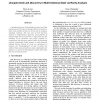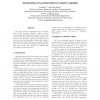118
click to vote
ICDM
2003
IEEE
15 years 6 months ago
2003
IEEE
Predictive data mining typically relies on labeled data without exploiting a much larger amount of available unlabeled data. The goal of this paper is to show that using unlabeled...
106
Voted
ICDM
2003
IEEE
15 years 6 months ago
2003
IEEE
Learning Bayesian network structure from large-scale data sets, without any expertspecified ordering of variables, remains a difficult problem. We propose systematic improvements ...
87
Voted
ICDM
2003
IEEE
15 years 6 months ago
2003
IEEE
Pattern-based clustering is important in many applications, such as DNA micro-array data analysis, automatic recommendation systems and target marketing systems. However, pattern-...
81
Voted
ICDM
2003
IEEE
15 years 6 months ago
2003
IEEE
A spatial outlier is a spatially referenced object whose non-spatial attribute values are significantly different from the values of its neighborhood. Identification of spatial ...
100
click to vote
ICDM
2003
IEEE
15 years 6 months ago
2003
IEEE
Clustering is the process of grouping a set of objects into classes of similar objects. Because of unknownness of the hidden patterns in the data sets, the definition of similari...
ICDM
2003
IEEE
15 years 6 months ago
2003
IEEE
104
click to vote
ICDM
2003
IEEE
15 years 6 months ago
2003
IEEE
We note that a set of statistically “unusual” proteinprofile pairs in experimentally determined database of protein-protein interactions can typify protein-protein interaction...
119
Voted
ICDM
2003
IEEE
15 years 6 months ago
2003
IEEE
A significant portion of knowledge discovery and data mining research focuses on finding patterns of interest in data. Once a pattern is found, it can be used to recognize satisfy...
101
Voted
ICDM
2003
IEEE
15 years 6 months ago
2003
IEEE
This paper presents interpretations for association rules. It first introduces Pawlak’s method, and the corresponding algorithm of finding decision rules (a kind of association ...
95
Voted
ICDM
2003
IEEE
15 years 6 months ago
2003
IEEE
Traditional methods for frequent itemset mining typically assume that data is centralized and static. Such methods impose excessive communication overhead when data is distributed...




